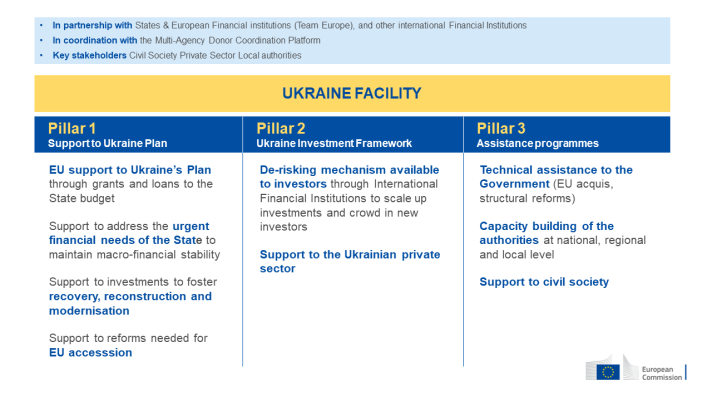50bn euros from the EU: Funding rules and Ukraine's obligations regarding received aid
Establish the Ukrainian Facility and implement other transformations that will help in the country's recovery
The European Commission on Tuesday, 20th June, released a draft Regulation for the establishment of a separate special instrument to support the financing needs of Ukraine's reconstruction with indicative funding of up to €50 billion for the period 2024-2027 – the Ukraine Facility. Vitaliy Nabok, a policy and data analyst at the Institute of Analytics and Advocacy, told Mind about the funding rules and how the Ukrainian fund will operate.
All the information provided in the article is based on the draft regulation and published communication materials from the European Commission.
Read also: More money or promises? What to expect from the London conference on the recovery of Ukraine
Preconditions for the adoption of the decision to establish the Ukraine Facility
The proposal to create the Ukraine Facility was submitted just before the start of the International Conference on Ukraine's Recovery, which took place this year in London on June 21st and 22nd.
The creation of such a mechanism is part of the review of the EU's long-term budget – the Multiannual Financial Framework (MFF) for the years 2021-2027.
The need to change the funding priorities of the EU budget has been long overdue and is caused by several factors, such as russia's full-scale invasion of Ukraine, migration, tackling the consequences of the pandemic and inflation, and overcoming economic and energy crises. To this end, the European Commission has proposed changes to the current budget, one of which is the creation of the Ukraine Facility.
The Ukraine Facility is a special instrument managed by the European Commission, aimed at providing short- and medium-term financing for Ukraine's recovery and reconstruction from 2024 to 2027. The creation of such an instrument ensures stable and predictable funding, which will have a positive impact on the country's macro-financial stability.
Furthermore, the funds provided under the Ukraine Facility will contribute to the implementation of key reforms for rapid EU accession, and the transition to a green, digital, and inclusive economy.
Structure of the Ukraine Facility
The support directions in the Ukraine Facility programme are as follows:

Table 1: Areas of support for the Ukraine Facility. * – up to 1% are resources required for technical and administrative assistance for the implementation of the Ukraine Facility.
Within the framework of the first component, the Ukrainian government is required to prepare the plan for the recovery, reconstruction, and modernisation of the country (Ukraine Plan), as well as to detail the reforms and investments it intends to undertake in the process of EU accession. Funding for this component will be provided based on the plan's implementation. The focus will be on public administration reform, good governance, the rule of law, anti-corruption efforts, and sound financial management.
The second component of support is aimed at attracting and mobilising public and private investments for the recovery and reconstruction of Ukraine in support of the plan's implementation. It will complement all existing support instruments for Ukraine, such as blended financing and guarantees, with the possibility of expansion as conditions allow. The EU also commits to establishing a special guarantee institution for Ukraine.
The final component involves technical assistance and other support measures, including the mobilisation of reform expertise, support for municipalities, civil society, and other forms of bilateral assistance typically available to countries under the Instrument for Pre-Accession Assistance (IPA).
Support will also be provided to achieve the goals of the Ukraine Plan. This component may involve funding for other initiatives, particularly in ensuring compliance with international law regarding crimes committed by russia on the territory of Ukraine.
Read also: Rebuilding Ukraine after its victory: What we need to be doing now
Features of Ukraine Facility Funding
The mechanism will partially replace the bilateral support currently provided to Ukraine. This includes the package of macro-financial assistance+ (MFA+) of €18 billion and the Neighbourhood, Development, and International Cooperation Instrument (NDICI). Under the latter, programmes that have already been adopted within the NDICI framework will continue to operate, but after the Ukraine Facility regulation comes into effect, new bilateral assistance under the NDICI will not be provided. Other financial assistance instruments will remain available to Ukraine.
The novelty of the Ukraine Facility compared to the current MFA+ package lies in the fact that the funding will be based on the Recovery Plan proposed by the Ukrainian government, which will link the allocation of funds to the implementation of sectoral and structural reforms. This will provide a coordinated medium-term vision of expected recovery, reconstruction, and modernisation measures closely related to the prospect of EU accession.
The plan will contain conditions related to:
- the main requirements present in MFA+ (macro-financial stability, budgetary oversight, public financial management, etc.);
- sectoral and structural reforms.
The conditions will be divided into intermediate steps with clear end dates.
Payments will be made according to a fixed quarterly schedule based on payment requests submitted by Ukraine and after verification by the European Commission of satisfactory compliance with the respective conditions.
Grants for the components of the Ukraine Facility will be accumulated through a new special instrument called the Ukraine Reserve. The reserve fund is intended to accumulate at least €2.5 billion annually. Within the second and third components of the Ukraine Facility, grants will be provided based on submitted projects.
Loans will be guaranteed by the reserve capital, similar to the financing within the current package of macro-financial assistance+ (MFA+). Loans will be provided on highly favourable terms with a maximum repayment period of 35 years and the commencement of principal repayments no earlier than 2034. Additionally, from January 1, 2024, to December 31, 2027, the EU will cover the costs of interest payments.
The mechanism also opens up the possibility of utilising contributions from other donors. The allocation of contributions from other donors should be based on the work of the G7-coordinated multi-donor assistance platform.
Furthermore, revenues obtained from frozen russian assets may also be used as a contribution to the recovery and reconstruction of Ukraine.
Transparency and accountability in the use of funds
The Ukraine Facility is a system of measures aimed at ensuring transparency, audit, and control, with components that will be present both in the EU and in Ukraine.
First and foremost, as part of the reforms outlined in the Ukraine Plan, the audit and control systems of the Ukrainian government are expected to undergo a significant improvement.
Ukraine is also required to establish a monitoring system, and it is expected to provide annual reports to the commission on the implementation of the Ukrainian portion of the plan. This will include reporting on Ukraine's internal control system and any amounts that were improperly paid or used for purposes other than intended and eventually returned to the EU. Proportional reporting requirements will be imposed on Union funding recipients who have received funds under the second and third components of the Ukraine Facility.
Additionally, Ukraine will be obliged to disclose information about individuals and legal entities receiving funding exceeding the equivalent of 500,000 euros for the implementation of the reforms and investments specified in the plan.
Secondly, the European Commission will be granted the right to check projects at any stage of the project cycle concerning the implementation of the plan.
The Commission will conclude a framework agreement with Ukraine regarding the implementation of the Ukraine Facility, including mandatory provisions on management, control, supervision, monitoring, evaluation, reporting, and auditing of funds, as well as measures to prevent and investigate violations, fraud, corruption, and conflicts of interest.
The control mechanisms related to the Ukrainian investment programme and technical assistance will be based on the systems, rules, and procedures of international financial organisations and implementing partners involved in the implementation.
Thirdly, a special independent audit board will be established to assist the Commission by regularly reporting on the use of funds spent to achieve the objectives of the fund and providing recommendations to Ukraine.
Read also: Second Front: How much aid Ukraine receives from abroad and why it is time to show where the money is being spent
Ukraine must approve the Recovery Plan
The European Commission's proposal for the creation of the Ukraine Facility should be reviewed by the European Parliament and the EU Council, along with other proposals for the revision of the multiannual financial programme.
After its adoption, Ukraine will be asked to submit its own Recovery Plan, outlining the reforms and investments it intends to undertake. Following its assessment, the European Commission will propose to the EU Council the approval of the plan and establish the conditions that Ukraine must meet to receive support.
The European Parliament and the EU Council are invited to urgently consider this proposal and implement it starting from the beginning of 2024.
Ukraine will commence the preparation of the plan and engage in discussions with the European Commission simultaneously, in order for it to comply with the Regulation requirements and be swiftly approved once it becomes effective.
The European Commission will oversee the expenses for Ukraine's recovery
The EU proposal is based on the need to revise the Multiannual Financial Framework (MFF) for the years 2021-2027 and realign priorities in funding. One of the proposed changes to the budget is the creation of a new financial instrument called the Ukraine Facility, which will be managed by the European Commission.
The Ukraine Facility has three priority components for funding: support for the implementation of the Ukrainian Recovery Plan, an Investment Programme for Ukraine, and a Support Programme.
The instrument is intended to meet the funding needs for Ukraine's recovery process from 2024 to 2027. The Ukraine Facility will replace two other instruments, MFA+ (which is in effect during 2023) and NDICI. Additionally, within the framework of the third component, types of assistance that are typically available to countries under the Instrument for Pre-accession Assistance (IPA) will be accessible. Therefore, the fund replaces the support provided to Ukraine under the IPA.
The funding will be multi-channel and flexible. Funds will be provided in the form of grants, loans, contributions from other donors, and revenues derived from frozen russian assets.
The Ukraine Recovery Plan is expected to be submitted by the Ukrainian government and to include reforms aligned with the goals of EU accession. Funds will be gradually allocated based on the progress of implementing these reforms outlined in the plan.
To ensure transparent and accountable use of funds from the Ukraine Facility, steps will be taken both by Ukraine and the EU. Ukraine is required to enhance its control and auditing systems and establish a monitoring system for fund utilisation. The European Commission, on its part, will have the authority to verify projects at any stage. Additionally, an independent audit board will be established to regularly report on the use of funds and provide recommendations to Ukraine.
You can read more about other instruments and funds available within the EU that Ukraine can potentially utilise here.
The OpenMind authors, as a rule, are invited experts and contributors who prepare the material on request of our editors. Yet, their point of view may not coincide with that of the Mind editorial team.
However, the team is responsible for the accuracy and relevance of the opinion expressed, specifically, for fact-checking the statements and initial verification of the author.
Mind also thoroughly selects the topics and columns that can be published in the OpenMind section and processes them in line with the editorial standards.




